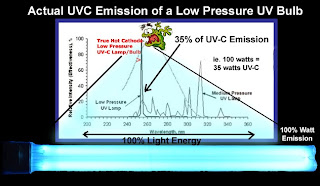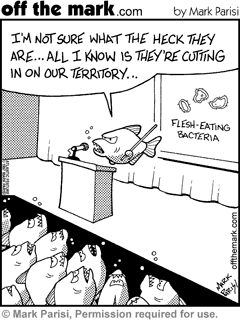High Output UVC Emission from a UV Bulb/Lamp; Aquarium or Pond
OVERVIEW;
Actual UVC output from your Aquarium/Pond UV Bulb/Lamp
A great point was brought up in one of our blogs specify geared to sterilizers and UV bulbs.
All the time, we hear about the wattage a bulb of any kind uses.
A standard light we use in our homes are 60 watt bulbs.
In water sterilizers, the bulb might be a 30 watt bulb.
The point made and the question now being; does a 30 watt UV-C bulb emit 30 watts of useful sterilizing watts?
And, the answer is No.
The UV-C wattage emitted is not the same wattage of a lamp.
Wattage of a bulb can be misleading. Watts used in a bulb is the power consumption of a bulb.
A 60 watt bulb used 60 watts of power. The actual output of a bulb is directly related to the wattage.
The higher the watts used, the great the power consumption.
But what is noteworthy, is that the wattage though does not actually tell us how much useful output the bulb has, or how efficient it is.
The efficiency of the bulb is the actual output of the bulb.
This efficiency is what becomes important as we look for a replacement for our UV Sterilizer/Clarifier or even a new UV Sterilizer as most of what is sold via the Internet or discounter brick & mortar stores are LOW OUTPUT medium pressure UV bulbs/lamps with as little as 25% of the UVC of the vastly better low pressure high output UV lamps sold but by a handful of high end sellers.
So please read on and beware if the price seems too good.
ADVERTISEMENT
Specify speaking about UV-C bulbs, they have a light energy spike at a certain wavelength of light (254nm). This light energy is what sterilizes.
With any UV-C bulb, there will be an energy spike at this lighting level as well use some of it lighting energy on other parts of the lighting spectrum.
The light emitted at the UV-C namometer of light is the useful energy or wattage used from the bulb. The other energy emitted on the lighting spectrum that is not UV-C is essentially wasted energy.
Therefore the wattage of the lamp is not the same wattage being emitted of UV-C.
A 30 watt UV bulb does not emit 30 watts of UV-C.
Take a look at this picture which shows the energy spike of a UV bulb. At this spike, light energy has sterilizing abilities.

In a premium low pressure true UV bulb, the actual UV-C emission of the bulb is about 35%. If you have a 30 watt UV bulb, it will emit 10.5 watts of germicidal UV-C.
Nail curing UV Bulbs, are commonly sold on Amazon & eBay for aquarium pond use at a lower cost (generally for retails prices of $5 to $15).
These are usually medium pressure UV bulb with a low 7-10% output of useful UV-C irradiation. These lamps have a wholesale cost of only a few $ for the smallest ones.
What buyers should also be aware of is how many hours the lamp/bulb is rated to last as true HO low pressure UV lamps burn themselves up quickly with only 4000 hours at peak performance. So if the lamp advertises 8000-10,000 hours--- AVOID IT!
The fact remains, that a true High Output "low pressure mercury" UV lamp/bulb has a distributor cost of at least $10 for even the smallest/cheapest of lamps, so if it is selling for this cost you know you are NOT get what you need to best run your UV Sterilizer or even Clarifier
As well the Halogen UV bulbs sold in some mini UV Sterilizers also have little of the peak UVC irradiation, more in the UVB range (these too are sold at discounters such as Amazon, not quality professional UV Sterilizer sellers). A good example of a UV Clarifier sold with these UV lamps is the Cobalt Aquatics Micro-UV which besides using the lower output Halogen UV lamp/bulb, it has very poor dwell time.
Both of these types of these low cost UV bulbs are marginal for clarification at best, certainly NOT level one or higher UV Sterilization unless used at very high wattages per water flow!! When combined with the lower dwell time that most of these Sterilizers that utilize these medium pressure lamps have (generally compact UVs), you are looking 1/4 the killing/sterilization/clarification power!!
An example would be comparing a TMC Vecton 15 Watt to a Jebaeo 55 watt that is commonly supplied with medium pressure UV lamps/bulbs (15 x 4 = 60).
As an example, if you have a 9 Watt UV Sterilizer (such as the Turbo Twist), and when the bulb is due for replacement you utilize one of the low cost medium pressure UV Bulbs, you will be getting 1/4 to 1/3 the output of a premium low pressure bulb.
The bottom line is to not be tempted by the low prices of the nail curing medium pressure UV Bulbs that many retailers either unknowingly or knowingly incorrectly market for pond or aquarium UV Sterilizer use!
Please Reference:
UV Sterilization; Basic Factors
Recommended Professional Source for Premium Low Pressure UV Bulbs:
*American Aquarium PREMIUM Low Pressure UV Bulbs; Compact Style
*American Aquarium PREMIUM Low Pressure UV Bulbs; Straight Tube Style (for Aqua Ultraviolet, TMC, more)
Normally, the actual emission of a UV bulb is something you will not need to worry about, but what you do what to make sure is you are getting a large enough sterilizer for the water quantity you are looking to sterilization.
Company’s that know what they are talking about will publish this information or keep it in mind, when giving recommendation.
If you are not sure, make sure to look for what kind of bulb/lamp the sterilizer has and how much UV-C you are actually getting.
Labels: Actual Emission, Aquarium UV Bulb, Nail Curing UV, Nail UV Bulb, Pond UV Bulb, Useful Energy, UV Bulb, UV Bulbs, UV-C, UVC, Wattage, Watts

 UV Sterilization in Aquariums and Ponds; How it works
UV Sterilization in Aquariums and Ponds; How it works





 TMC PRO Pond 110 Watt
TMC PRO Pond 110 Watt